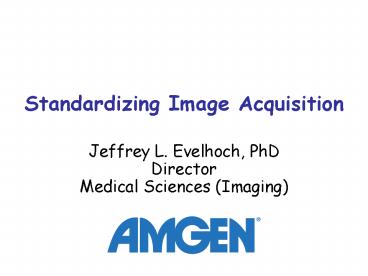Standardizing Image Acquisition PowerPoint PPT Presentation
1 / 22
Title: Standardizing Image Acquisition
1
Standardizing Image Acquisition
- Jeffrey L. Evelhoch, PhD
- Director
- Medical Sciences (Imaging)
2
Why standardize acquisition?
Best Image Processing Ever
3
Issues to consider
- Manufacturer-based differences
- Technology changes
- Not all sites are created equal
- QC for quantitative v. diagnositic imaging
- Appropriate method depends on
- Exact question
- Image analysis methods
- Who will mind the shop
4
An Example Consensus Protocol
- DCE-MRI
- Early phase clinical trials for drugs targeting
tumor blood supply - Low molecular weight gadolinium chelates
- 1.5 Tesla
5
A Brief History
- October 1999 NCI Workshop ? consensus
recommendation - Included both treatment response and breast
diagnosis - March 2002 CRUK PTAC Workshop ? consensus
recommendation - Treatment response in early clinical trials
- Nov 2004 NCI Workshop ? consensus recommendation
- Treatment response in early clinical trials
6
NCI Workshop Participants
- Jeffrey Abrams
- Thomas Chenevert
- Laurence Clarke
- Jerry Collins
- Jeffrey Evelhoch
- Susan Galbraith
- Michael Knopp
- Jason Koutcher
- Martin Leach
- Nina Mayr
- Daniel Sullivan
- Edward Ashton
- Peter Choyke
- Patricia Cole
- Gregory Curt
- Milind Dhamankar
- Michael Jacobs
- Gary Kelloff
- Adrian Knowles
- Lester Kwock
- Peter Martin
- Teresa McShane
- Anwar Padhani
- Stefan Roell
- Mark Rosen
- Gregory Sorensen
- Charles Springer
- Michael Tweedle
- Donald Williams
- Antonio Wolff
7
Specific recommendations for
- Type of measurement
- Requirements for contrast agent injection
- Primary endpoints
- Secondary endpoints
- Nomenclature
- Data reduction
- Region of interest
- Images acquired prior to contrast injection
- Dynamic acquisition protocol
- Measurement requirements for primary endpoints
- Trial design
- Image analysis
8
Lets consider issues approaches adopted to
address those issues
9
Manufacturer-based differences
e.g., Sequence names e.g., Sequence names e.g., Sequence names e.g., Sequence names
Sequence GE Philips Siemens
Gradient echo GRASS FFE GRE
Spoiled Gradient echo SPGR T1FFE FLASH
Inversion Recovery MPIR IR-TSE TurboIR
10
Approaches
- Need access to experts on all systems
- Use basic sequences (differences smaller)
- Tweak parameters to match as closely as possible
- Make certain reconstruction methods are as close
as possible - Same reference standard on all systems
11
Technology changes ? keep it simple
- 1.5-T (for near future)
- Basic sequences (less likely to change with
upgrades) - Parameters (at least) one step back from cutting
edge - Use analysis with considerable experience within
community, most forgiving - Revisit recommendations periodically
12
Not all sites are created equal
- Keep it simple
- Training, training, training,
- Routine QC
- Careful monitoring
- Immediate feedback
13
QC for quantitative v. diagnositic imaging
- Requires higher performance
- MR system
- Sequences
- Set-up procedures
- Radiological processes
- Better here
or here?
14
Appropriate method
- For breast cancer diagnosis want dynamic
temporal-spatial resolution trade-off
M. Schnall,MRM 2001
15
Who will mind the shop?
16
Summary of key recommendations fordata
acquisition
17
General Issues
- Entry criteria should consider tumor size in
relation to pharmacological mechanisms, MRI
resolution, sensitivity to motion and potential
confounding factors from previous treatment
(e.g., radiation) or rapid tumor growth rates - Tumors in a fixed superficial location should be
at least 2 cm in diameter other tumors should be
at 3 cm in diameter - Adjust orientation so that motion is in-plane
when motion effects cannot be avoided (e.g.,
liver, lungs)
18
Pre-injection
- Acquire high quality clinical images of entire
anatomic region (preferably in two orthogonal
planes) - Acquire T1- and T2-weighted images registered in
the same planes as the dynamic data - If possible, measure T1 (using same resolution
and field of view for dynamic data)
19
Contrast agent injection
- Use power injector to minimize variation
- Injection dose should be standardized by weight
- 15-30 sec for total injection, at least 20 cc
saline flush - Document injection site, use same site for
subsequent studies in same subject - Minimum of 24 h between studies
20
Dynamic study (I)
- For first 150 sec after bolus injection, use
fastest sampling possible consistent with spatial
resolution/anatomic coverage requirements, but
not slower than 20 sec temporal resolution
21
Dynamic study (II)
- Acquire data out to at least 8 min (continual
sampling is optional) - If possible, include in imaging volume a
normalization function (e.g., arterial or other
tissue) - For serial studies, imaging volume of interest
should be adjusted to sample same region of tumor
22
Summary
- Development application of appropriate protocol
requires close academic-industry interaction - For multi-center studies
- Keep it as simple as possible while still getting
the required info - Clarity education up front is essential
- Non-standard methods require substantial
continuous support

